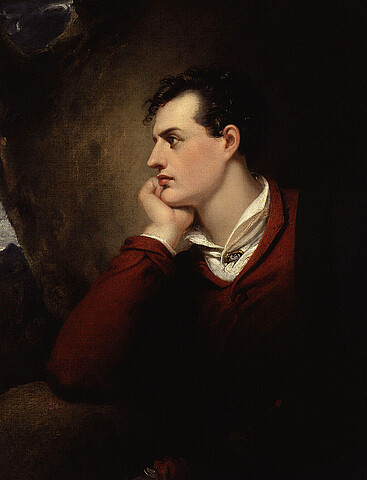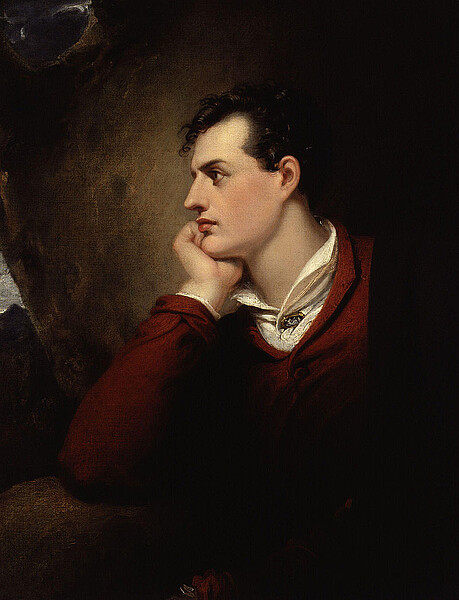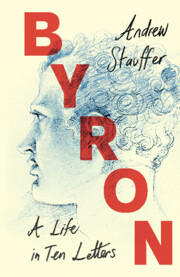Lord Byron’s Many Masks
Andrew Stauffer is professor and the Chair of the Department of English at the University of Virginia. Since 2013, he has served as the President of the Byron Society of America and has overseen numerous conferences, research projects, and MLA panels in this function. He is a renowned expert on Romanticism, editor of the poetry of Lord Byron and Robert Browning and of H. Rider Haggard’s novel She: A History of Adventure. He is the author of the books Anger, Revolution, and Romanticism (Cambridge University Press, 2004) and Book Traces: Nineteenth-Century Readers and the Future of the Library (University of Pennsylvania Press, 2021). His most recent monograph Byron: A Life in Ten Letters (Cambridge University Press, 2024) was released on the bicentenary of the Romantic poet’s death to rave reviews, including one in the London Sunday Times that called it “ingenious” and “devilishly readable.”
Andrin Albrecht: I’m not working on Lord Byron specifically, but my dissertation is Romantic ideas of genius and how they resurface in the fiction of Vladimir Nabokov, Thomas Pynchon, and Mark Z. Danielewski, so the figure of Byron is inevitably at the back of my mind. I still vividly remember my first contact with him: In 2017, I participated in a student theater production of Tom Stoppard’s Arcadia, where, though he never actually appears on stage, characters constantly talk about Byron. I had never heard of him before that, but when I started reading up on him, I found his poetry mesmerizing. Do you have a Byron origin story?
Andrew Stauffer: Throughout my undergraduate years, Byron wasn’t much on my radar. I liked the Romantic poets, but Byron isn’t taught in the US as much as one might think. We spent more time on Keats and the Romantic lyric, on Shelley, Wordsworth. It was classes with Jerome McGann at the University of Virginia, where I got my graduate degree, that made me realize I needed to take this poet more seriously. Because it was with McGann, this course was less about the Byronic worldview and more about the kind of ground-level attention to how he produced his poetry. That really pays dividends with Byron’s work, because you get out of the realm of myth and rumors, and really get into him as a craftsman and a user of language.
A.A.: I really enjoyed reading your book Byron: A Life in Ten Letters, because it was not just informative but also just superbly readable! There were several moments when I thought: “How is this not a Netflix show?”
A.S.: That’s certainly also helped by the fact that I structured the book in ten episodes … Byron is a very modern figure that way: I try to present him as not just a relic from the Regency era but really as someone who’s struggling with issues of identity, sexuality, creativity, class, mental illness, and climate change, all the things that he’s in the midst of. He’s involved, in a sense, with all of them, so I tried to present him as a figure for our time as well as a figure from his own.
A.A.: What definitely helped this was your choice to start each chapter with one of Byron’s own letters. While his poetry remains more on the sidelines than in some more traditional biographies, he emerges as a writer of other forms. His voice is startlingly contemporary in these letters, especially the humor in them holds up by 21st century standards.
A.S.: Yes, that’s right! I had often appreciated him, like many people appreciated him, as a letter writer, and I’ve recommended his letters to friends, but I wouldn’t know where to tell them to get started. How do you begin the 3,000 letters that Byron left behind – do you just start at the first and keep going? You need the life braided with the letters so you know where he was, who he was writing to, what were the stakes of a letter. I initially thought of the book as a selection of letters with a lot of annotations, but as the project evolved I realized you actually need to know the whole scope of his life because you need to know where a letter catches him in his journey. So, pretty soon it morphed into a biography with the letters front and center where we get, as you say, his voice at the outset, but a more tessellated picture of his personality and his experiences.
A.A.: What was your method of boiling down his 3,000 letters to this selection of 10?
A.S.: You know, I spent years reading Byron’s letters, so I had a pretty good sense of the classics, the really good ones that I wanted to include, but as I started to put together the puzzle of the table of contents I realized that I needed each letter to do a certain kind of work. It had to be from a different period of his life, ideally to a new correspondent, ideally in a new location, because he moved so much and you’d want to track his movements. That narrowed it down very quickly. Moreover, I committed to print the letters in full. It’s one thing to say I’m going to have a juicy quotation to start the chapter, but to say no, I’m going from “Dear X” to “yours sincerely, Byron,” that letter better be worth the journey and not have a lot of dead wood in it.
A.A.: One of the factors that makes Byron such a spellbinding figure is his own participation in mythmaking, to the extent that nowadays there are two radically distinct figures: the Byron of public memory and Byron, the historical person. To what extent did you find yourself working from Byron’s own words, and to what extent did it actually feel like an arguing back at them, deconstructing the persona that Byron himself was crafting?
A.S.: It’s difficult because Byron is such a projector of selves, both in his poetry and in his letters, and really even in conversations. His friends complained that he was a chameleon. He had that feature – or maybe that defect – of his personality, so it’s sort of a fool’s game to try to find out which is the “real” Lord Byron. Where does the mask end and the man begin? He wrote in ways that encouraged his audiences to see him as a figure of scandal, of Satanic passions and things like that. He didn’t try to hide that – in fact, he seems to have exaggerated in some cases just how wicked he was. For me, starting with the letters helped, because you see different selves; different voices emerge to different correspondents. I finished the biography knowing more about Byron, but having a no clearer sense of exactly where his bedrock allegiances lay. He said, famously, that the two things he’s constant in are a strong love of personal liberty and a detestation of cant and hypocrisy, but there are so many different Byrons layered on top of that. After all that we know, all the biographies, all the memoirs, all the letters – in some ways we know Byron better than we know our best friends – he still eludes us.
A.A.: I wanted to ask about Byron’s relationships to some of his contemporaries. I’ve always been fascinated by his friendship with Percy B. Shelley. It is so easy to romanticize: Here’s Shelley, this beatific, famous vegetarian – and at the same time as a widely known atheist – and then there is Byron, this satanic philanderer … They seem to have felt a great deal of mutual attachment and respect, but there are also passages in your biography where you hint at this friendship of opposites not having been quite as picture-perfect …
A.S.: Yes, they are in certain ways men of contrasts: Shelley the optimist, the believer in perfectibility of man, the vegetarian, the high-minded political rebel, unpopular in his own time, unable to sell much of his poetry ... Byron, the most popular poet of his time, very much a creature of the senses, a hedonist at many times, and a cynic, a sceptic about man’s perfectibility. They had a lot of interesting philosophical conversations – they meet essentially right after the Battle of Waterloo, the return of the monarchs of Europe to their thrones. I think they recognized in one another right away that the other was a genius, but a genius of a related but different order. They were curious about each other, seeing the other as someone to contend with. Shelley says this explicitly: “I despair of rivalling Lord Byron, as well I may, and there is no other with whom it is worth contending.” Byron has his eye on Shelley as, in his perception, a pure poet. He must have recognized that Shelley was technically the better poet, exquisite in terms of his use of verse form and language … They both had different strengths, and they drew on each other, they were inspired by each other, particularly in the summer of 1816 and 1817 when they were traveling together, and again in Venice and Pisa a little later … Their lives are intertwined in fascinating ways, and I think their work explores two opposing but related perspectives on how you write political poetry post-Waterloo.
A.A.: Do you know if Byron played an active role in Shelley’s posthumous canonization?
A.S.: Byron defended Shelley right after his death. The conservative press was like “Well, Mr. Shelley has drowned, now he shall find out if there is a Heaven or no.” Byron retorts that “Shelley was a great man, every man compared to him is a beast …” However, Byron himself didn’t live much longer. Soon after Shelley’s death, he got into the Greek revolutionary cause that Shelley himself had championed, and died before Mary Shelley [Percy’s wife, the author of Frankenstein, A.A.] had a chance to produce the posthumous edition of Shelley’s work that would become the basis the reconsideration of his reputation. There are a lot of reasons why Shelley then went on to eclipse Byron in the 20th century, but they had to do with the fact that the strangeness of Byron’s poetry was not as amenable to New Critical methods of close reading as his friend’s.
A.A.: On the flipside of that, there are a couple of major poets of his day – most specifically Samuel Taylor Coleridge, William Wordsworth, and also John Keats – at whom Byron made some pretty vicious stabs. How representative are these juicy quotes (e.g., calling Keats’s poems “mental masturbation”) actually for Byron’s overall attitude towards these poets? And was his vitriol directed specifically at them, or was it more of a blanket barrage against other major players of the literary scene at the time.
A.S.: Each of these cases – Wordsworth, Coleridge, and Keats – is a little different. Byron had a kind of allergy to Keats’s poetry; he saw it as vulgar and overwritten and self-stimulating, kind of gauche or gaudy, but after Keats’s death, he moderated this criticism a bit, saying something like, “I wouldn’t have been so harsh if I knew he was going to die so quickly!” Moreover, Shelley died with a copy of Keats’s poetry in his pocket, so obviously those two men must have had some interesting conversations about what Shelley admired in Keats. Byron made fun of Coleridge as part of the Lake School poets, whom he had distanced himself from, but he also helped Coleridge get his poems Christabel and Kubla Kahn published. Byron found things to admire in Coleridge, so much so that he was like, “this needs to see print, and I’ll put you in touch with my publisher!” Wordsworth is more complicated still. Byron was constantly heaping scorn on Wordsworth because he recognized Wordsworth was probably the great poet of the day, someone that you couldn’t ignore or belittle the way you might with Keats, and yet Byron disapproved of Wordsworth’s provincialism and his increasingly conservative political stance. Byron’s work often shadows Wordsworth’s in interesting ways: Even when he doesn’t directly quote him, you can see him measure his own path against things that Wordsworth has done. They were two giants of the age who cordially hated one another and did not like what the other one was doing, but couldn’t help be affected by the gravitational force of the other as their careers developed.
The second part of the interview can be found under the following link: https://www.gestern-romantik-heute.uni-jena.de/kultur/artikel/lord-byrons-many-masks-part-ii


